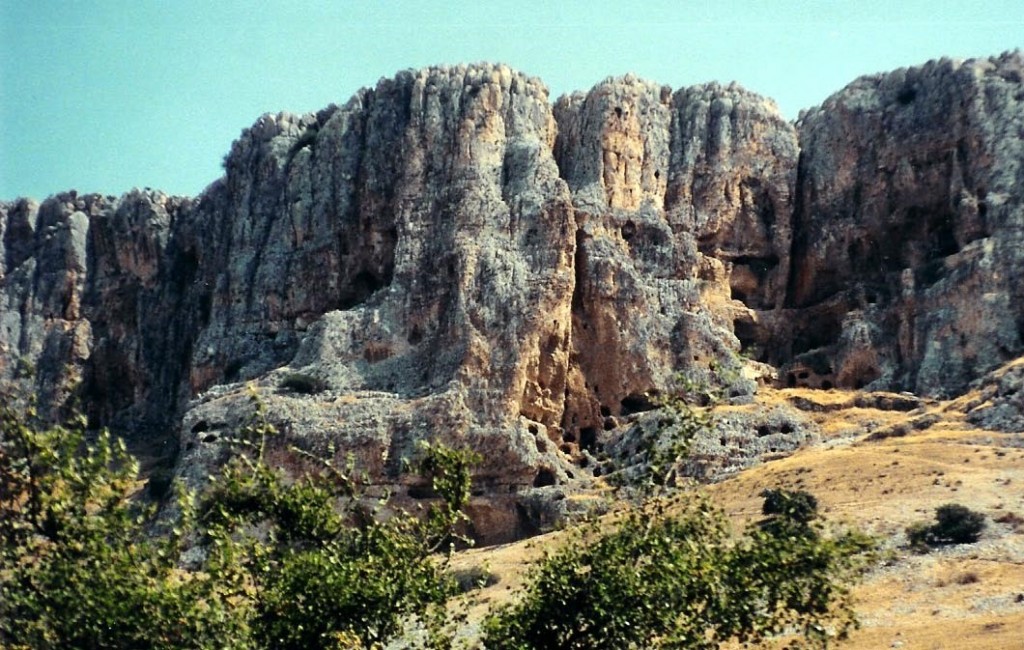03.05.26 37 – 4 B.C. Conquest and Rule by Herod the Great
By the time Herod took control of his country, it lay in ruins. In the towns of Lydda, Thamna, Gophna, and Emmaus nearly all the residents had been captured and deported as slaves.[1] The village of Marissa was burned to the ground by the Parthians.[2] Everyone lived in constant fear and had great distrust of any leader over them – pagan or Jewish. While life was better than it was under Antiochus IV Epiphanes, economically, little had changed – one tyrant was replaced by another.[3] The prosperity that came after the Maccabean Revolt had suddenly ended. No wonder then, that, decades later, the Sermon on the Mount would be a stunning word of promise and encouragement!
There were a number of reasons why the Jewish people hated Herod the Great. His father Antipater, was an Idumean[4] and his mother Kypros, came from the family of an Arab sheik.[5] Herod’s genealogy begins with Esau (Gen. 36) whose descendant was Amalek the father of the Amalekites (Gen. 36:16; Ex. 17:8-16), who was the father of Agag, also a king of the Amalekites (1 Sam. 15), whose descendant was Haman of Queen Esther’s day (Est. 3). Scripture record that Haman was an Agagite (Esther 3:1) but Josephus said he was part of a clan within the larger tribe of Amalekites,[6] a small tribe within the larger tribe of Idumeans (descendants of Esau). Haman was a forefather of Herod the Great. More specific details as to why the Jewish people hated Herod the Great are as follows:
- Some fifteen centuries earlier, the Edomites refused to permit their Israelite cousins to pass through their land on their way from Egypt to the land of Canaan. The ancients did not forget or forgive.
- David conquered the Edomites and Solomon reigned over them (1 Sam. 14:47).
- In the ninth century B.C., the prophets Joel and Amos denounced the Edomites as the bitterest enemies of God (Joel 3:19; Amos 1:11-12).
- The prophets Ezekiel and Jeremiah also denounced the Edomites (Ezek. 35:13; Jer. 19:7-22).
- The Edomites, by this time known as the Idumeans, joined the Chaldeans in the final conquest of Judea when Nebuchadnezzar came to destroy Solomon’s temple.
- After Nebuchadnezzar deported the majority of the Jews, the Idumeans raided the impoverished surviving Jewish people who were left behind.[7] They survived the three Babylonian invasions[8] but then were confronted repeatedly by the Idumeans.
- Many Idumeans stood with the Greeks against the Jews during the Inter-Testamental period.
- About 130 years before Jesus, John Hyrcanus forced circumcision on non-Jewish men in an attempt to convert them to Judaism.
- However, the most important issue for the Jews was that Herod simply did not have the biblical requirements to be their king.
The Romans were aware of these cultural and religious issues and believed the Jews would not follow him into a revolt.[9] They were right. Under Herod’s command, Roman soldiers defeated the Parthians in Jerusalem and slaughtered whatever Jewish freedom fighters they could find. Much to his surprise, Herod was also able to obtain soldiers and financial assistance from both the Samaritans and Hellenized Jews. Consequently, the hostility between orthodox Jews, Hellenized Jews, and Samaritans at the time of Christ was explosive. Jesus could not have come at a time filled with more tension.
This was also a time of turmoil in Rome. Caesar had been assassinated and Gaius Sossius joined Mark Anthony, by whom in 38 B.C., he (Sossius) was appointed governor of Syria. Israel at this time was a province under Damascus, Syria. As governor, Sossius supported Herod against Antigonus (the Hasmonean) when the latter controlled Jerusalem. In 37 B.C. Herod captured Jerusalem and Sossius placed Herod upon the throne. Later the Roman Senate confirmed the decision by Sossius and gave Herod the official title of rex socius et amicus populi Romani, meaning Allied King and Friend of the Roman People.
But Herod never enjoyed peace and tranquility because he was in constant fear thinking that a Jew would kill him and steal his throne. He even ordered his two favorite sons killed while they were in service for him in a fortress in Samaria.[10] His army consisted of foreign mercenaries, Idumeans, and Samaritan soldiers, but his personal bodyguards were selected foreign mercenaries because he even feared his own soldiers.[11]
After the fighting ended, the Senate re-titled him as King of all of the Jews. The title further offended the Jews. He was the most loyal of all puppet monarchs in the Mare Nostrum, or Mediterranean provincial districts. Significant in this political mess is that He married Mariamne, the great-granddaughter of Alexander Jannaeus of the Hasmonean dynasty. He was wise enough to marry into the family he had overthrown, in the hope of gaining some degree of legitimacy for his reign. Even though she was his favorite wife out of ten, that would not stop him from eventually killing her and several other family members and potential rivals.[12]
One of his first decisions was to eliminate all possible challengers to his throne. Since the Sanhedrin had previously reprimanded him and supported Antigonus and the Parthians, he massacred nearly every member of the high court except a few as a celebration of his accession to the throne.[13] As was stated previously, Josephus says in Antiquities 14.9.4 (175) that Herod execute “all” the members, but in Antiquities 15.1.2 (6) the historian said that 45 supporters of Antigonus who were members of the Sanhedrin were executed. Among those who escaped death were the famous Hillel and Shammai, the two most prominent Jewish leaders of the second temple period. A new Sanhedrin was formed which was obviously much more responsive to Herod’s desires and control. Nonetheless, he made two significant changes.
- The Sanhedrin, which previously was both a legislative and judicial body, was stripped of its legislative role.
- The Sanhedrin’s judicial authority was limited to Jerusalem and Judea and, therefore, had no jurisdiction in Galilee or other Jewish enclaves.[14] For this reason, Jesus could minister freely in the Galilee area without worries of Caiaphas or the Sanhedrin challenging Him, although they did send out spies to observe Him.
Whereas previous political leaders often functioned also as the high priest, Herod refused this position. Rather, he sold the position to those he deemed trustworthy – namely the House of Boethus, a wealthy and influential Sadducean family. One of Herod’s good friends was Mark Anthony, after whom the Antonio Fortress (located beside the Jewish temple) was renamed. Anthony may best be remembered in secular history as the great Italian lover of Queen Cleopatra VII who ruled Egypt. The queen was very covetous and wanted to insure her position, so she had her brother poisoned. She manipulated Anthony to give her Jericho, which Herod had to lease back from her at high annual rent. Knowing of her passion for power and wealth, Herod lived in constant fear of an Egyptian military attack and, therefore, constructed several fortresses along his southern and eastern frontier.[15] But the most important fortress was the Antonia beside the temple.
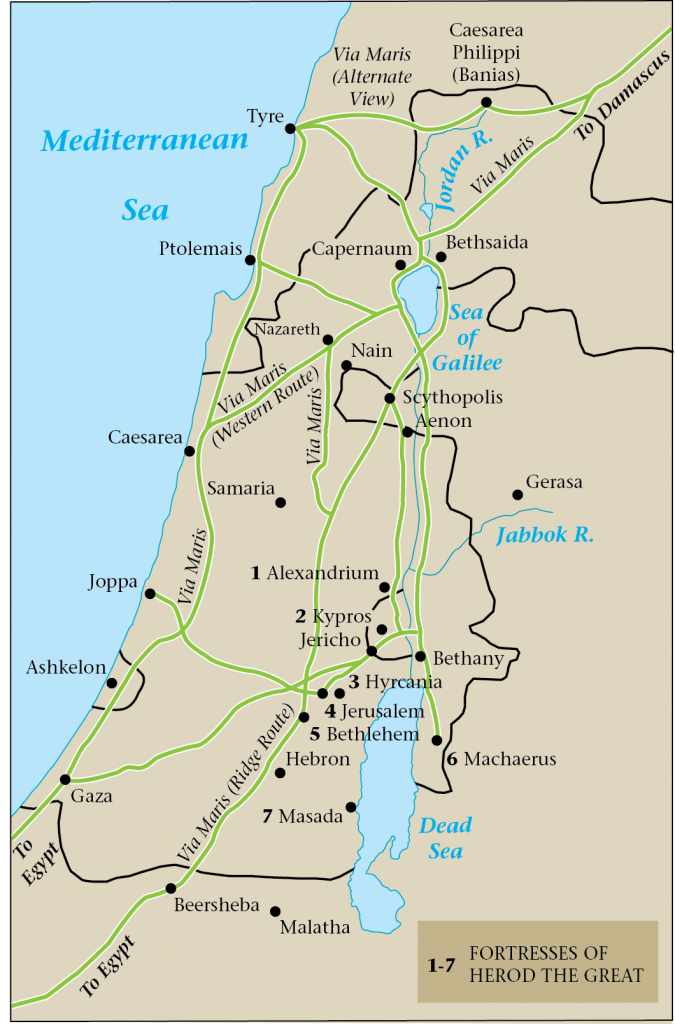
03.05.26.Z Map Of Fortresses By The Hasmoneans And Herod The Great. Herod the Great enlarged Hasmonean fortresses to defend against potential, or imagined threats from the Egyptians and the Parthians. Courtesy of International Mapping and Dan Przywara.
But the Parthians were not the only worries of Herod. He was not too delighted with Queen Cleopatra VII of Egypt. Her passion for Mark Anthony was well known, and there was always a degree of tension between her and Herod. To add insult to injury, Herod was humiliated that Mark had given her Jericho, which he (Herod) had to lease back from her. He could not enjoy his winter fortress palace there without paying her rent. It was there that he built his last fortress, one that he named after his mother – Kypros because he feared a possible Egyptian attack.
The desert city of Jericho was one of the very few areas where balsam trees grew which were highly esteemed for medicinal and cosmetic value. The town was a resting point for all travelers, especially caravans. Therefore, an auxiliary military unit was stationed there to aid the tax collector, Zachaeus, get his revenue. So to add humiliation to Herod, Queen Cleopatra frequently found great cause to visit Herod to insure that she was receiving all her lease royalties. At such meetings, each carefully considered how one could kill the other.[16]
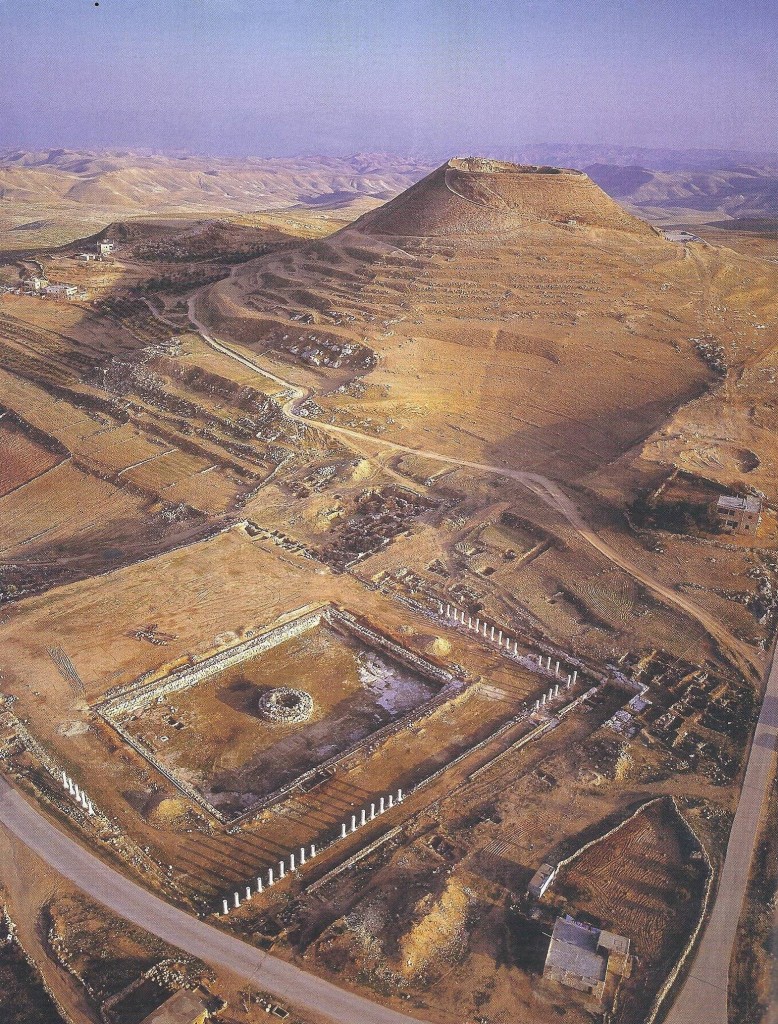
03.05.26.A. RUINS OF THE HERODIAN PALACE-FORTRESS. An aerial photograph of the palace – fortress built by Herod the Great is located two and a half miles south of Bethlehem. He took the top of one mountain (background) and placed it upon another to increase its height, then built a circular palace fortress on the top. At the bottom he had a swimming pool with guest houses. Since this is located near the edge of a desert, water was piped in from a spring near Bethlehem. The Herodian towers contained 20 rooms throughout the 7 stories The palace also had a full-size bathhouse and lush gardens.
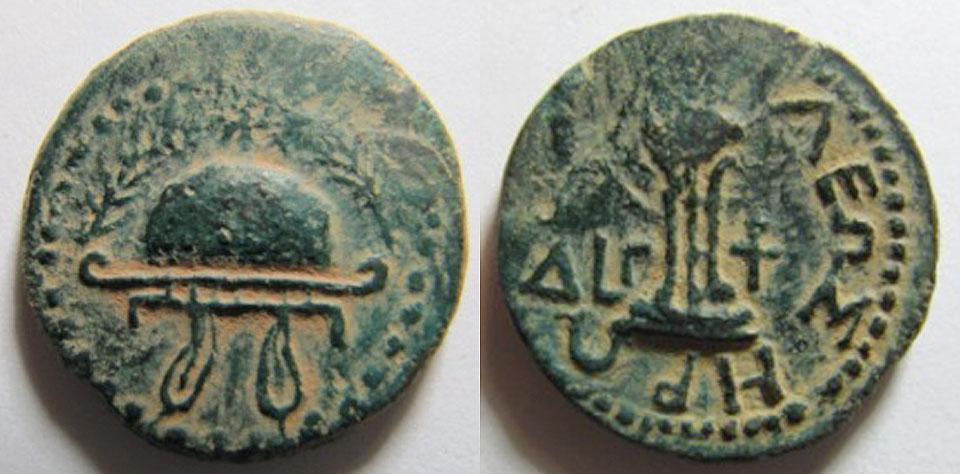
03.05.26.B. A COPPER COIN OF HEROD THE GREAT. The image of this eight protot coin reflects Herod’s dictatorial rulership. LEFT: Shown is a military helmet with cheek pieces and straps, wreathed with acanthus leaves, and two palm branches.
RIGHT: Reads HRWDOU BASILEWS (of King Herod), shown is a tripod with ceremonial bowl. Source http://www.edgarlowen.com/herod-10211.jpg
In the seventh year of Herod’s reign there was a power struggle between Caesar Octavian and Mark Anthony as to who would reign in the seat of the mighty Roman Empire. The soldiers who were loyal to each of the two commanders finally met at the Naval Battle of Actium in 30 B.C. And when it was over, Herod’s good friend Mark Anthony was defeated. When Cleopatra heard the news, she committed suicide.[17] Herod, in the meantime, was fighting the Arabs east of the Jordan River. During this conflict, he killed Hyrcanus of the Hasmonean family. As soon as he was able to restore some measure of peace in the land, he had to deal with the potential loss of his throne and possibly his life by the command of Octavian in Rome – the cost of being a good friend of Mark Anthony. Herod understood Roman politics very well and realized that since he was loyal to Anthony, the new Caesar would quite naturally be determined to kill him. Therefore, he made a splendid political move: He went to Rome with the finest political speech of his life. He confronted his would-be judge and executioner, and stated that he (Herod) would be loyal to him just as he was loyal to Mark Anthony. He also said that he was the best candidate for Rome to serve in the eastern front in the event that there would be an Arab or Parthian invasion. Octavian evidently believed his story and kept him in power. The puppet king then returned to Judaea with more status than before. He had a network of spies who informed him of potential uprisings and possible problems inside and outside his domain. He was a faithful and loyal friend to the emperor and offered his assistance whenever possible.
Now that his rule was secure, he began a number of huge construction projects. As a teenager he had studied engineering in Rome at a time when Augustus decided to enrich the Roman culture with theaters, hippodromes, and other architectural wonders. Herod desired to acquire the fame that Augustus achieved. So he also built theaters, aqueducts, roads, and many other buildings as well as an amphitheater and hippodrome in Caesarea Maritima along the coast.[18] Josephus said he then invited athletes from the surrounding nations to compete once every four years in Olympic-style games, giving expensive prizes to each winner.[19] He introduced chariot races with chariots drawn by two, three, or four horses. In the year 27 B.C. Herod introduced in Jerusalem, sporting events that included gladiator fights and wild animals fighting and devouring condemned criminals, much to the delight of Gentile spectators. But since there is only one account of a gladiator and wild animal fight in the Holy City, the conclusion by scholars is that there must have been an incredible Jewish protest against this form of barbaric entertainment.[20] Josephus said Herod built a theater in or near Jerusalem,[21] and he referred to a hippodrome south of Jerusalem.[22] But scholars do not know of their locations
These facilities and accompanying sporting events were enjoyed by the Sadducees and Hellenized Jews, but orthodox Jews looked upon them as deliberate attempts to destroy their faith and culture – an invasion of Greek and Roman paganism. Jerusalem was a mix of Jewish and Greek cultures – a truly cosmopolitan city.
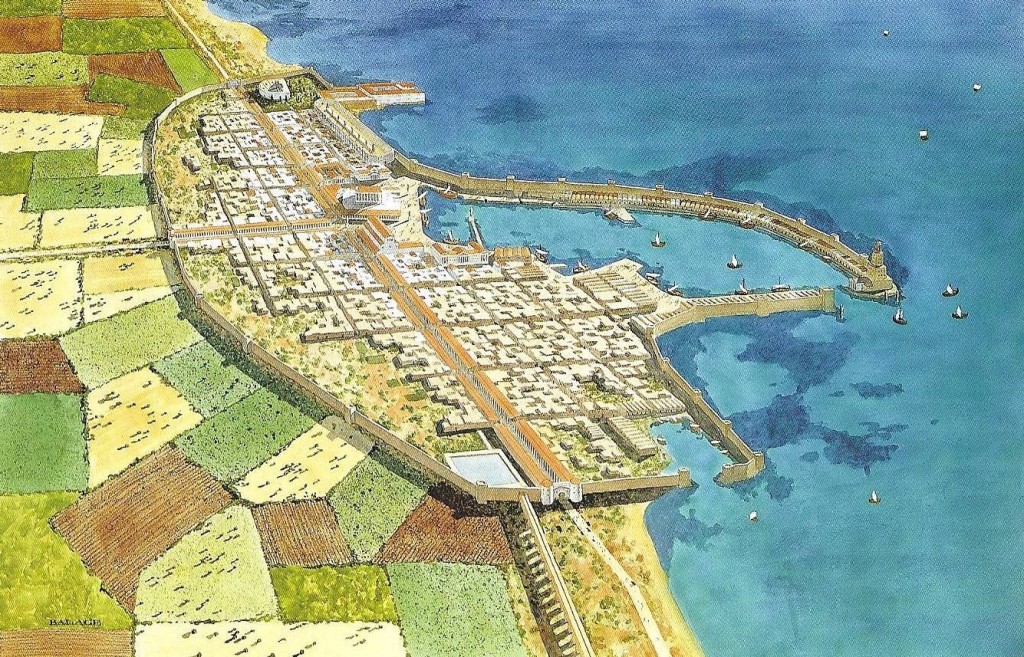
03.05.26.C. AN ILLUSTRATION OF CAESAREA MARITIMA. An artist’s rendering of Herod’s Caesarea “by the sea.” The city and its artificial port were built between 23-9 B.C., and was one of the wonders of the first century. He built an aqueduct to bring a continuous supply of fresh water and designed the sewer system so the tides would clean out the waste. Ships were safely guided into the port at night with a lighthouse. Recently archaeologists have determined that the ancient city was far larger than depicted in this rendering.
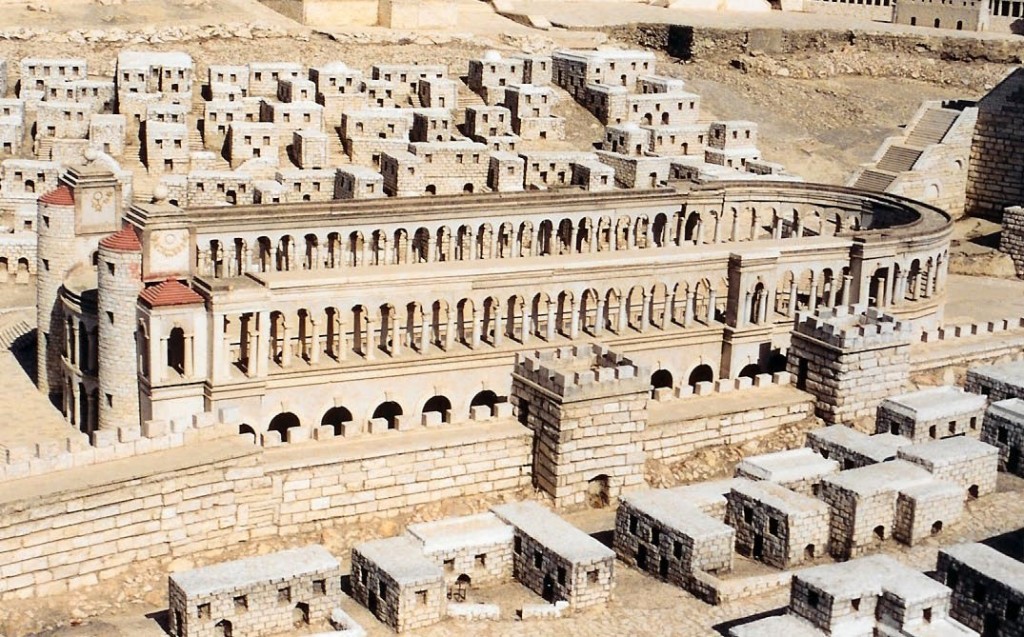
03.05.26.D. A MODEL OF HEROD’S HIPPODROME. Scholars are unsure where in Jerusalem Herod the Great built a hippodrome in Jerusalem. This 50:1 scale model, as shown in a miniaturized first century Jerusalem. But when the model city was relocated to the Israel Museum, the hippodrome was not included due to disagreements concerning location by various historians. Photograph by the author.
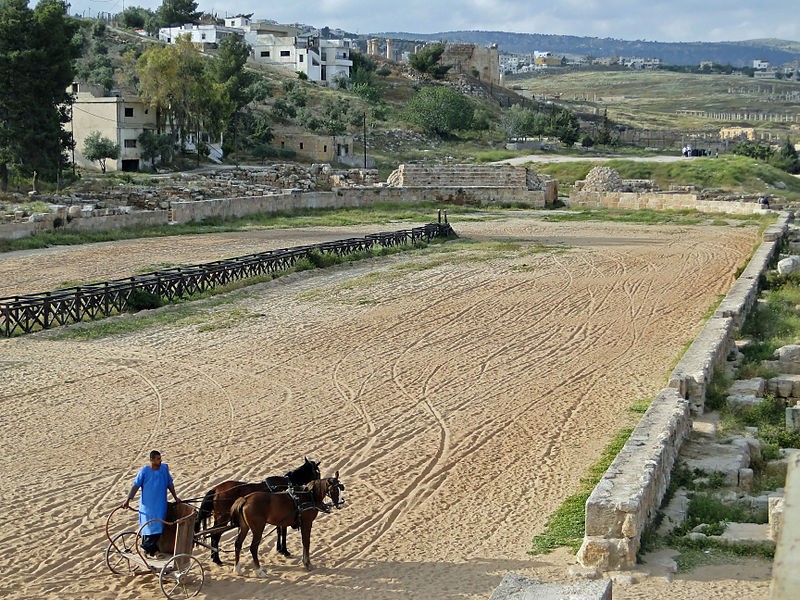
03.05.26.E. RUINS OF THE HIPPODROME IN JERASH. A modern charioteer is anxious to use the hippodrome in ancient Jerash, one of the ancient Decapolis cities. These were first used for horse and chariot races, then for animals and gladiators, and in the second century Christians were fed to the lions in hippodromes as well as amphitheaters. Photo courtesy of the Jordanian Bureau of Tourism.
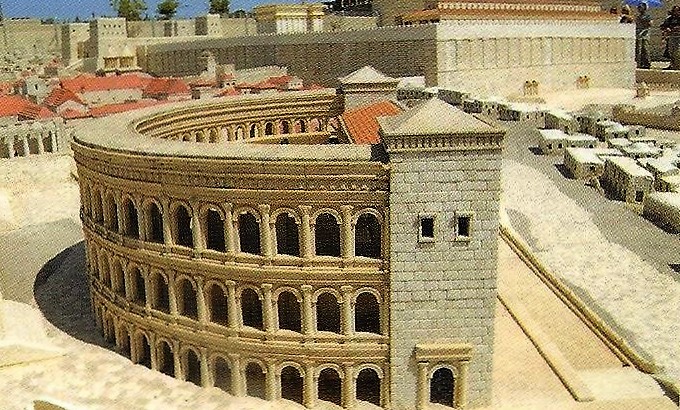
03.05.26.F. A MODEL OF HEROD’S THEATER. This 50:1 scale model of a Roman theater is typical of what scholars believe Herod constructed in Jerusalem but its location is unknown. However, archaeologists have uncovered several theater seat tokens for this theater mentioned by Josephus in Antiquities, 15.8.1.[23]
The subject of a theater and what Josephus meant when he said that the amphitheater of Jerusalem was located “in the plain” has been fuel for scholarly debates.[24] There is no disagreement, however, that Jerusalem was not the “pure little Jewish community” often envisioned by Bible students.[25] It was a cosmopolitan city with constant tension of cultural and religious conflict. The lack of archaeological evidence, other than some theater seat tokens, does not help the matter any. The theaters Herod built in Jericho and Caesarea are the oldest in the Middle East.[26]
Some have said that Herod’s goal was to make Caesarea the Rome of the Middle East. Rome, which had a reputation for outlandish sports and depraved social life, was Herod’s ideal city. In true Greek and Roman tradition, most games were incredibly violent.[27] Scholars debate as to whether the Olympic games, which were played once every four hears, were in Jerusalem and/or in Caesarea. [28] He honored Caesar and other Roman dignitaries by hosting the 192nd Olympiad in the most lavish style possible. Josephus writes,
About this time it was that Cesarea Sebaste which he had built was finished. The entire building being accomplished in the tenth year, the solemnity of it fell into the twenty-eighth year of Herod’s reign, and into the hundred and ninety-second Olympiad. There was accordingly a great festival, and most sumptuous preparations made presently, in order to its dedication; for he had appointed a contention in music, and games to be performed naked; he had also gotten ready a great number of those that fight single combats, and of beasts for the like purpose; horse races also, and the most chargeable of such sports and shows as used to be exhibited at Rome, and in other places. He consecrated this combat to Caesar, and ordered it to be celebrated every fifth year.
Josephus, Antiquities 16.5.1 (136-138a)
The word naked to the Greeks and Romans meant complete nudity whereas to the Jews the term meant wearing nothing but undergarments, as was done by men during night time fishing on the Sea of Galilee. The word gymnasium is from the Greek word gymnos, meaning naked,[29] because the Greeks loved the human body. Athletes performed in total nudity and criminals were crucified in total nudity. In military terms, Josephus said the word meant to be without armor.[30]
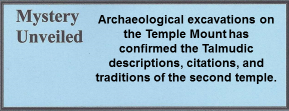
His feats in architecture were surpassed only by his ability to manipulate others, often with fear. His court was filled with Greek advisors who flattered him with the phrase “the great Herod.” This complementary title was eventually changed to “Herod the Great.”[31] The Greeks, as well as the Romans, believed the Jews were an uncivilized people and Herod was determined to prove them wrong by making Israel the pinnacle of Hellenism. As a result, the Jewish people had no government or temple authority that placed a check on the encroaching Greek culture. Of the four levels of Pharisees,[32] the upper echelon was as corrupt as the Sadducees, while the other three made an attempt to help Jews maintain their Jewishness. Unfortunately, as will be shown, the Pharisees did so by instituting the strict legalism called the “traditions of the elders” (Mt. 15:1-2).
Herod had statues of Caesar erected in Caesarea and Sabaste in Samaria. In Sabaste he built a temple to Caesar for those who desired to worshiop their emperor. But when he attempted to erect one in Jerusalem, the Jews greatly objected. Consequently, since the Samaritans did not raise similar objections, the Jewish hatred for them intensified.
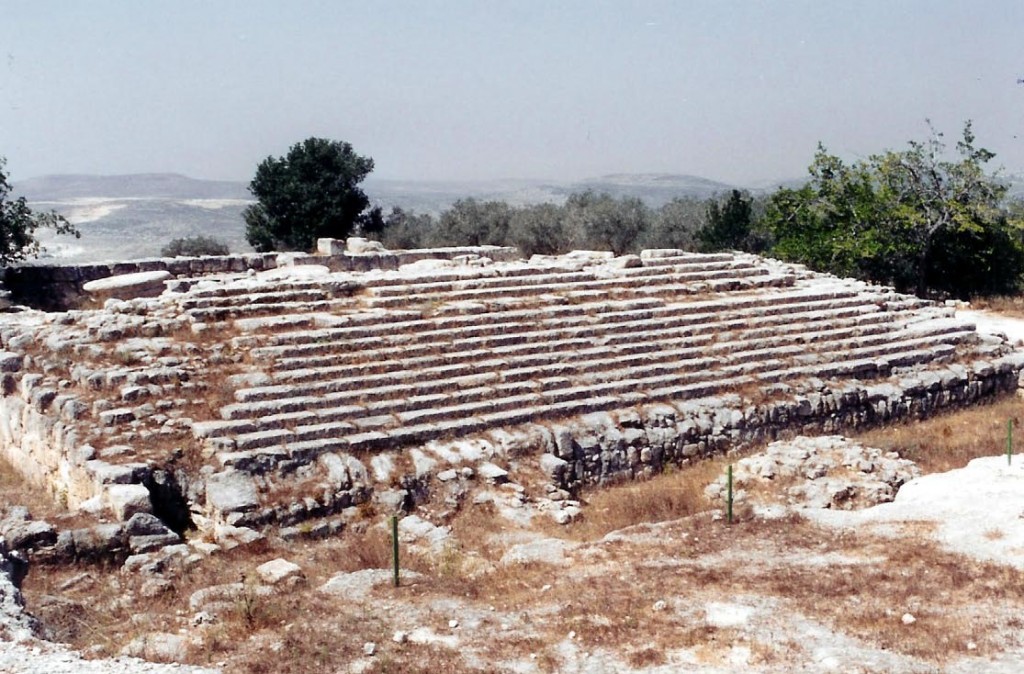
03.05.26.G. THE TEMPLE RUINS OF EMPEROR AUGUSTUS. Herod built a temple in Samaria so the Samaritans could worship Emperor Augustus. This reflects, in part, the deep influences of Hellenism in the region, even though he was hated by both the Jews and Samaritans. Photograph by the author.
From the time Alexander the Great conquered the land until the end of the Maccabean Revolt, Israel had been ruled by Greek dictators who promoted Hellenism. The cultural invasion intensified during the short reign of Antiochus IV Epiphanes. While the temple and Jerusalem were “purified” after the Maccabean Revolt, in the countryside vestiges of Hellenism continued. The ruling Maccabees were, for the most part, interested in power and wealth, not purifying the land other than Jerusalem.
When Herod the Great entered the scene, he reintroduced these pagan cultural icons. This was especially damning since they had just removed the yoke of tyranny from the Greek Seleucids, and now a son of Esau, who supposedly converted to Judaism under John Hyrcanus, was re-instilling paganism. However, to gain the respect of the Jewish people, his coins did not have any images of humans or deities. Nonetheless, outside of Jerusalem he built temples to worship various gods as well as the emperor. Statuettes of Asclepius, the god of healing, and his daughter Hygieia, the goddess of cleanliness and healing, have been uncovered in the seaport city Caesarea. Amazingly, when Jesus took His disciples to Caesarea Philippi (now known as Banias), He took them to the shrine of Pan, the most pagan city in the Holy Land and asked them, “Who am I?” The influence of the pagan Greek and Roman culture upon the Jewish people cannot be overstated.
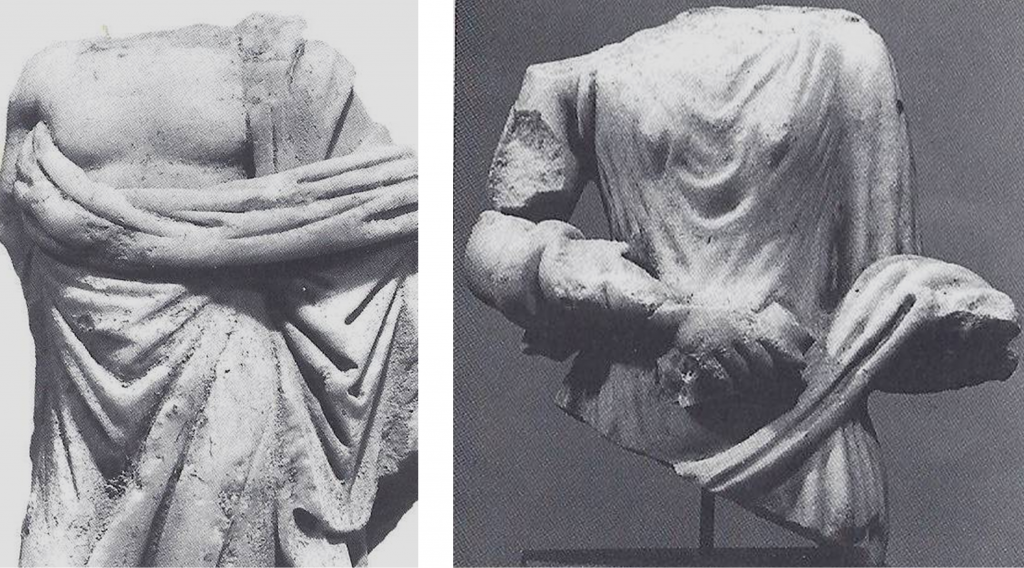
03.05.26.H. STATUETTES OF HEALING GODS. LEFT: Portion of a marble statuette of the god Asclepius (height 26 cm.) from Caesarea (Courtesy of the Sedot Yam Museum). RIGHT: Portion of a statuette of his daughter, the goddess Hygieia (height 24 cm.) from Caesarea Photographs courtesy of the Israel Antiquities Authority.
Under Herod’s ruthless leadership and Roman military might, he took control of nearby regions, many of which had been under Hasmonean control previously, but divided by Pompey. So now nearly all the land that God had promised to Abraham and his descendants was now in the control of a descendant of Esau, not Jacob. This was an abomination to the Jews. They wondered how people, such as the Idumeans who worshiped idols and lived in debauchery, could possibly inherit the land God promised to Abraham and His chosen people. They concluded that since God permitted most of the land area of the Davidic Kingdom to come under Herod’s domain, certainly the messiah was to come soon and take control of the resurrected kingdom. They interpreted the political and social events around them as prophetic indicators that their long awaited Davidic Kingdom was at hand, with the son of David as the conquering messiah on the throne.

Herod was a shrewd businessperson, taxing the Jews to the point of making them economic slave peasants. He taxed international caravans traveling through his district on the Kings Highway, located east of the Jordan River, and on the Via Maris that went through Capernaum. There is no question that he managed to squeeze every shekel out of every possible source, yet when he died his country was in the verge of bankruptcy and rebellion.
From 63 B.C. until the temple was destroyed in A.D. 70, there were thirteen freedom revolts,[33] and sixty claimants to the title of messiah.[34] Only one of them, Menahem ben Hezekiah, claimed to be a descendant of David.[35] The area around Galilee, especially Mount Arbel and Gamala, was a hotbed of rebellion. During the ministry of Jesus there was constant fear that, at the slightest clash or infraction, another rebellion would break out. Fear of war was constant, while the rest of the Roman Empire enjoyed the military-enforced Pax Romana.[36] Herod had his kingdom, wealth, and power, but he was miserable – there was no time to enjoy a peaceful life.
[1]. Josephus, Antiquities 14.11.2; Wars 1.1.9.
[2]. Josephus, Antiquities 14.15.12; Wars 1.15.4.
[3]. Geikie, The Life and Works of Christ. 1:43.
[4]. Josephus, Antiquities 14.1.3 (8); Wars 1.6.2 (123). .
[5]. Josephus, Wars 1.8.9 (181); Antiquities 14.7.3 (121). Scholars are unclear concerning the genealogy of Kypros (or Cypros) as there appear to be conflicts in the writings of Josephus on this matter.
[6]. Josephus, Antiquities 11:6.2-3.
[7]. Read the short book of Obadiah.
[8]. In the years 605, 597 and 587/86 B.C.
[9]. Most sources record that the appointment and title were given to Herod by the Caesar Augustus and confirmed by the senate (i.e. Mackowski, Jerusalem: City of Jesus. 175); however, other scholars indicate that it was by Anthony and confirmed by the senate (i.e. Flusser, Jesus. 259).
[10]. An excellent resource on the life of Herod the Great, besides Flavius Josephus (Antiquities) is Steward Perowne, The Life and Times of Herod the Great. London: Hodder and Stoughton, 1957.
[11]. Pilch, The Cultural Dictionary of the Bible. 106; Saperstein, Essential Papers on Messianic Movements and Personalities in Jewish History. 94.
[12]. See the Maccabean family tree at 03.05.02.A.
[13]. Wilkinson, Jerusalem as Jesus Knew It. 87; Josephus, Antiquities. 14.9.4; Mantey, “New Testament Backgrounds.” 6.
[14]. Golub, In the Days. 195.
[15]. The seven major fortresses are: (1) the Alexandrium (also known as Alexandreion or Sartaba) in the Jordan Valley to defend the northern region, (2) Masada border palace fortress in the southern region, (3, 4) the Doq and the Cypros (Kypros) border fortresses that overlooked Jericho, (5) the Hyrcania Prison fortress, (6) the Machaerus, on the eastern edge of the Dead Sea, and (7) in Jerusalem, a palace-fortress beside the temple, that was later renamed by Herod the Great as the Antonia Fortress. Some fortresses, such as the Herodian, were his in original contruction while he modified other fortresses such as the Antonia, Masada, and Machaerus. For more information on Herod’s fortresses, see Samuel Rocca, The Forts of Judaea 168 BC-AD 70. New York / London: Osprey Publishing 2008. See location map at 03.05.26.Z below.
[16]. Books 15 and 16 of Josephus’ Antiquities describe the details of the life of Herod the Great; See also Blaiklock, “Herod.” 7:816-17.
[17]. Stein, R. Jesus the Messiah. 71-73.
[18]. Theaters were semicircular whereas amphitheaters were circular. The Greeks built them into hillsides that had natural accommodating formations, however, the Romans who used arches and developed concrete, built free-standing structures. Both had tiered seating that surrounded the theatrical performance area. Hippodromes were constructed for horse races.
[19]. Josephus, Antiquities 15.8.1 (268).
[20]. Goodman. “Under the Influence.” 62, 65-66.
[21]. Josephus, Antiquities 15.7.1; 15.7.4 and 15.8.1.
[22]. Josephus, Wars 2.3.1 (44) and Antiquities 17.10.2 (255); See also Sanders, “Jesus in Historical Context.” 434-36.
[23]. Charlesworth, Jesus and Archaeology. 44-45.
[24]. Josephus, Antiquities 15.8.1 (268); See also Sanders, “Jesus in Historical Context.” 435.
[25]. Lichtenberger, “Jesus and the Theater in Jerusalem.” 283, 288-91.
[26]. Lichtenberger, “Jesus and the Theater in Jerusalem.” 299.
[27]. King Agrippa, the grandson of Herod the Great, was also a builder who constructed an amphitheater in Berytus (today’s Beirut, Lebanon). According to Josephus, at one time 1,400 gladiators fought there in a single contest (Antiquities 19.7.5).
[28]. Josephus, Wars 1.21.7 (414); See also Sanders; “Jesus in Historical Context.” 430.
[29]. Scott, Jr. Jewish Backgrounds of the New Testament. 127.
[30]. Josephus, Antiquities 8.14.2.
[31]. Goulb, In the Days. 206.
[32]. See 02.01.14.Q1.
[33]. See Appendix 25 for a listing of false prophets who had messianic expectations and for a partial listing of revolts and social disturbances from 63 B.C. to A.D. 70.
[34]. Geikie, The Life and Works of Christ. 2:114.
[35]. Jerusalem Talmud, Berakhoth 2.4, 5a.18. Menahem ben Hezekiah was a major leader in the revolt of A.D. 66 (Josephus, Wars 2.17.8). For more than a hundred years the Hezekiah family was involved in various revolts, and mutinies. This has given credibility to some that they were of royal lineage as they claimed.
[36]. Lee, The Galilean Jewishness of Jesus. 72-73; Mellowes and Cran, Executive Producers. From Jesus to Christ: The First Christians. (DVD). Part 1.
